Jane Hampton Cook's Blog, page 12
December 23, 2014
Giving while Grieving–Jackie Kennedy’s Christmas Print, 1963
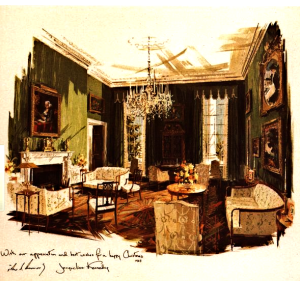 On the morning of November 22, 1963, the art director for Hallmark Cards in Kansas City mailed 200 prints of a water color of the White House Green Room to Jackie Kennedy at the White House. The boxes arrived at a Washington D.C. airport less than 30 minutes before President John F. Kennedy died from an assassin’s bullet in Dallas.
On the morning of November 22, 1963, the art director for Hallmark Cards in Kansas City mailed 200 prints of a water color of the White House Green Room to Jackie Kennedy at the White House. The boxes arrived at a Washington D.C. airport less than 30 minutes before President John F. Kennedy died from an assassin’s bullet in Dallas.
Though grief struck, in the weeks that followed, Jackie drew strength by giving to to others at Christmas. She gave the Green Room prints to the White House staff as a “continual reminder of the President.”
The painting of the Green Room had special meaning because it showed the Green Room after its renovation. Passionate about preserving history and art, Jackie had led an effort to restore the historical character of the White House by acquiring furniture and art. In this way, she turned the White House into a museum and established the White House Historical Association. Artist Edward Lehman had painted water colors of the restored Red Room, Green Room, and Blue Room. Prints of Lehman’s Red Room painting had served as the Kennedy’s Christmas gift to the White House staff in 1962.
Ever the visionary, Jackie had invited Lehman to spend Christmas in 1963 at their Virginia home so he could paint a water color of Kennedys in front of their personal Christmas tree.
Also before the assassination, she had written a Christmas message for Look magazine. Jackie had observed that while the White House is often the center of national attention, it simultaneously serves as the home of an American family anticipating the joy of the Christmas season.
“But through Christmas, we keep unbroken contact with the simple message of the redemption and love that God sent into the world so many years ago,” Jackie Kennedy.
Source: Seeley, Mary Evans. Season’s Greetings from the White House, p. 86-99.
Jane Hampton Cook is the author of eight books, including American Phoenix, http://www.americanphoenixbook.com.

December 21, 2014
What gift did John Quincy Adams give America on Dec. 24? Peace on Earth
 Originally posted on Jane Hampton Cook:
Originally posted on Jane Hampton Cook:
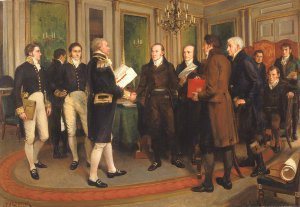
John Quincy Adams signs the Treaty of Ghent, Dec. 24, 1814
Exactly 200 years ago on Dec. 24, 1814, John Quincy Adams gave Americans the best Christmas gift he could possibly give to a nation at war: a peace treaty.
“I consider the day on which I signed it as the happiest of my life; because it was the day on which I had my share in restoring peace to the world,” Adams reflected.
After intense negotiations in Ghent, Belgium, Adams and four other Americans signed the Treaty of Ghent, which created lasting peace between America and England.
Adams led a team that included Treasury Secretary Albert Gallatin, House Speaker Henry Clay, Senator James Bayard, and diplomat Jonathan Russell. The British negotiators were Lord James Gambier, Henry Goulburn, and Williams Adams.
The talks began in August 1814, only to quickly stall with no real progress. “At present I do not think that the negotiation will…
View original 691 more words

How did Calvin Coolidge Save $500 by Lighting the First National Christmas Tree?
President Calvin Coolidge was known as Silent Cal, thrifty with his words and also thrifty with his pocketbook.
Because he didn’t want to spent the extra $500 to install a button at the White House to turn on the lights for the first National Christmas Tree, President Calvin Coolidge and his wife Grace walked to the Ellipse on the South Lawn on Dec. 24, 1923. There he pushed a button with his foot to turn on 3,000 lights adorning a 60-foot fir tree from Vermont, his birth state.
Three years later, Coolidge became the first president to issue a Christmas Day message, which was printed in newspapers across the country.
“Christmas is not a time or a season but a state of mind. To cherish peace and good will, to be plenteous in mercy, is to have the real spirit of Christmas. If we think of these things, there will be born in us a Savior and over us will shine a star sending its gleam of hope to the world,” Calvin Coolidge, Dec. 25, 1927.
Christmas in America started out as a holy day primarily observed by Anglicans, or members of the Church of England who settled colonies, such as Virginia. The Common Book of Prayer guided observers through the Advent season and the twelve days of Christmas.
Some religious Puritans, who settled in Massachusetts in the 1600s, outlawed Christmas celebrations for a time because they wanted to reform the English church. The traditions of decorating homes and churches with greenery, singing carols, hosting balls, and drinking eggnog became so popular, that Christians of most denominations adopted them.
The merriment and joy of this holy day became a national holiday in 1870, when President Ulysses Grant established Christmas Day, New Year’s Day, and July 4, as national holidays to bring Americans together after the divisive Civil War.
Jane Hampton Cook is the author of eight books, including American Phoenix, http://www.americanphoenixbook.com.

A Rock and Roll White House Christmas – Elvis and Nixon, 1970
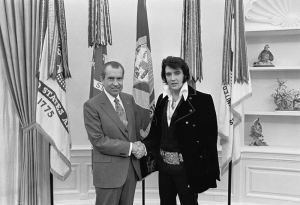 Elvis Presley’s photograph with President Richard Nixon is the most requested photo from the National Archives. The unusual pair met during Christmas week in 1970.
Elvis Presley’s photograph with President Richard Nixon is the most requested photo from the National Archives. The unusual pair met during Christmas week in 1970.
Chided by his father about spending too much money on Christmas gifts, including “more than $100,000 for 32 handguns and ten Mercedes-Benzes,” Elvis fled to Washington DC.
After arranging a secret meeting in the Oval Office, Elvis gave President Nixon a Christmas gift—a colt .45 pistol.
A collector of police badges, Elvis also asked the president to give him a badge from the Federal Bureau of Narcotics and Dangerous Drugs. Nixon agreed.
Their icon photo shows a contrast in appearances between two men — one flashy, one traditional.

What gift did John Quincy Adams give America on Dec. 24? Peace on Earth

John Quincy Adams signs the Treaty of Ghent, Dec. 24, 1814
Exactly 200 years ago on Dec. 24, 1814, John Quincy Adams gave Americans the best Christmas gift he could possibly give to a nation at war: a peace treaty.
“I consider the day on which I signed it as the happiest of my life; because it was the day on which I had my share in restoring peace to the world,” Adams reflected.
After intense negotiations in Ghent, Belgium, Adams and four other Americans signed the Treaty of Ghent, which created lasting peace between America and England.
Adams led a team that included Treasury Secretary Albert Gallatin, House Speaker Henry Clay, Senator James Bayard, and diplomat Jonathan Russell. The British negotiators were Lord James Gambier, Henry Goulburn, and Williams Adams.
The talks began in August 1814, only to quickly stall with no real progress. “At present I do not think that the negotiation will be of long continuance,” he confided in his wife, Louisa, who was living in St. Petersburg, Russia, where John Quincy had been serving as a high ranking diplomat.
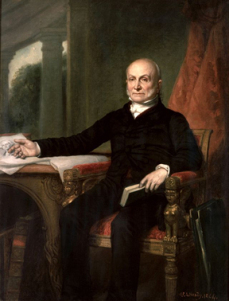
John Quincy Adams
“Your fears of bad news from America in the autumn fill me with alarm, and I open all your letters with trembling, lest I should find some horrid circumstance relating to our families or friends,” she responded.
That bad news took place on August 24, 1814, when the British military burned the U.S. Capitol and White House. Dispatches about the burning reached Ghent six weeks later in early October. The British negotiators, who had suggested lowering the boundary line between Canada and the United States, now had the upper hand at the peace talks. Adams was both discouraged and outraged.
“It must indeed have been for some of my own sins or for those of my country, that I have been placed here to treat with the injustice and insolence of Britain, under a succession of such news as every breeze is wafting from America.”
Louisa, too, wondered if America would survive.
“The news of the destruction of Washington makes much noise here [in St. Petersburg] and they seem to think as you say that all America is destroyed. Everybody looks at me with so much sorrow and compassion that I hate to stir out,” she reflected.
Many Europeans, however, considered the burning of Washington’s architectural treasures as unprecedented.
“The destruction of the capitol, the President’s House, the public offices, and many private houses is contrary to all the usages of civilized nations, and is without example even in the wars that have been waged during the French Revolution,” Adams observed.
“There is scarcely a metropolis in Europe that has not been taken in the course of the last twenty years. There is not a single instance in all that time of public buildings like those being destroyed.”
Louisa soon began to notice that the burning of Washington was backfiring on the British among other European diplomats.
“It is said that the destruction of our little capitol has produced such a sensation here that his little lordship [the British ambassador to Russia] has more than once been under the necessity of retiring from the soirées in which it has formed the topic of conversation,” she conveyed to her husband.
Likewise, the British government hoped to gain clout at the Congress of Vienna, which was meeting at the same time in Austria to redraw Europe’s map after the Napoleonic Wars.
“Should they [the British] succeed in Vienna, we shall have no peace, because they will prefer war with us, to peace upon any terms,” Adams worried.
But the British lost power at the Congress of Vienna when France offered to give back the territory they had gained through Napoleon and return to their pre-war boundaries.
Then came the game changer. Adams and the other American negotiators learned that Americans had successfully repelled the British military at Baltimore, Maryland, and Plattsburgh, New York.
Emboldened, the American negotiators drafted a treaty that kept the boundary line between the United States and Canada as it was before the war, ante-bellum. Though this offer violated their weeks-old instructions from President Madison, they believed the risk was worth it. Adams was relieved when they received new instructions from Madison suggesting the ante-bellum terms.
“In the instructions that we have now received [from Madison], dated 19 October, we are expressly authorized to make the same identical [antebellum] offer. The heaviest responsibility therefore, that of having trespassed upon our instructions, is already removed,” Adams wrote to Louisa.
“For the first time I now entertain hope that the British government is inclined to conclude the peace . . . We are now in sight of port. Oh! that we may reach it in safety!”
They arrived in safety. After a robust back and forth, the negotiators came to terms and signed the Treaty of Ghent on Dec. 24, 1814, a Christmas gift that has given America and Britain a lasting peace for 200 years.
Jane Hampton Cook is the author of eight books, including American Phoenix, her book on John Quincy and Louisa Adams and the War of 1812.

November 13, 2014
The Sergeant Who Saw the Remains of Saddam Hussein and Made an Ethical Choice
On Veterans Day this week, Robert O’Neill spoke about shooting Usama Bin Laden and the mission behind it. O’Neill relayed his story to Peter Doocy of the Fox News Channel.
Hearing O’Neill’s story reminded me of an ethical choice made by Sergeant Joseph Bills, who came face to face with the remains of Saddam Hussein after his execution through the Iraqi judicial system. Though tempted to snap a photo of Hussein, Sergeant Bills made a different decision.
Discover what he did in this this excerpt from, Stories of Faith and Courage from the War in Iraq and Afghanistan, a book I co-authored with Jocelyn Green and John Croushorn.
“SERGEANT BILLS, grab the chaplain, let’s go.” It was 6 PM on December 30, 2006. My colonel seemed urgent to get on the helicopter— but then, we considered all Hero Missions urgent, so I didn’t think much about it. I just moved. Hero Missions were the name of helicopter missions deployed to recover the remains of Americans killed in action in Iraq.
“We have to go now,” he said again. We flew in two different birds to Baghdad in case anything should happen to one of them.
After landing on one of small bases there, I noticed secret service men walking around. Okay, what’s going on? I wondered.
I soon learned that the remains we were about to collect were not those of a hero at all. We were picking up the remains of Saddam Hussein, hanged that morning, and to be delivered back to his hometown of Tikrit. We got the mission because we transfer remains, and we were in charge of the north where Tikrit is.
The officials in Baghdad had wanted to bury him in an unmarked grave there in Baghdad and keep its location a secret. But his family was there, pleading with them to be able to take the body home for a burial. After eight hours, the officials gave in.
Finally, around 11 PM, we were ready to go. The family wanted to verify the identity of the body, so they unzipped the body bag. We all stood around staring into that face. Here was the dictator that had so oppressed his people. Here was the tyrant America had spent years fighting.
At least, here was his body.
The magnitude of the scene was not lost on me—I wanted to somehow document the moment, but snapping a picture of his body was out of the question.
Instead, once we were back in the helicopter, I took a picture of myself just to capture the date and time. It may look like an ordinary picture to anyone else, but when I see it, I’ll always remember—that was the moment after I had seen the face of evil, and had seen that he had met justice once and for all.
***
Jane Hampton Cook is the award-winning author of eight books, including her newest America’s Star-Spangled Story and American Phoenix.
http://www.janecook.com/books.htm


November 9, 2014
What I Saw Before the Fall of the Berlin Wall–25 years ago

The Berlin Wall shown from West Berlin, May 1989.
The Berlin Wall fell 25 years ago today. I wasn’t there when it fell but had the opportunity to see the wall in person a few months earlier as these photos show. In May 1989 I traveled throughout Germany with a choir from Baylor University. Though seeing the concentration camp at Dachau was the most sobering part of our trip, witnessing both sides of the Berlin Wall was like traveling through a time warp, with West Berlin reflecting the cars and culture of the 1980s and East Berlin appearing stuck in the 1960s. Today I’m glad that both East and West are thriving in the year 2014.

Representing Baylor University, Jane Hampton Cook and Lisa Mazon stand in front of the Berlin Wall in May 1989.
Germany has long been a special place to me for one simple fact. I was born there. A member of the U.S. Army, my father was stationed in Germany when I was born. Though the war had ended decades earlier, he was part of the U.S. government’s post World War II agreement to keep military forces in Germany.
Though I didn’t understand the politics or the significance of Ronald Reagan’s 1987 “Tear Down this Wall” speech when I saw the wall in 1989, I understood its injustice. The Berlin Wall had been built overnight in 1961 to prevent East Germans on the communist side from fleeing to the economic prosperity found in West Germany on the democratic side.
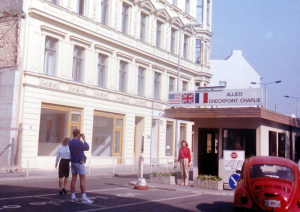
Baylor students take photos at the famous Checkpoint Charlie in Berlin.
My father had told me stories of how the wall had divided families, preventing them from being together. In the early days, parents would hold up babies to show grandparents on the other side the grandchildren they would never meet.
When the wall came down on November 9, 1989, I felt a connection to it because I had just seen it with my own eyes and had heard those stories. Because I’ve never lived under communism, I couldn’t truly understand the emotions of those who tore it down. But I could see the joy on their faces as they participated in the most historic event of the decade.

An image of an East German soldier at a Soviet monument before the Berlin Wall fell.
Over the years, my path has frequently and unexpectedly intersected with the wall in ways I never imagined or sought out. While working at Texas A&M University in 1997, I had the opportunity to plan a ceremony dedicating the eye-catching outdoor bronze sculpture “The Day the Wall Came Down,” which is part of the George Bush Presidential Library in College Station, Texas. A large segment of the wall is part of the library’s interior.
As someone who studies and writes about U.S. presidents today, I’ve been asked several times to talk about Reagan’s “Tear Down this Wall” speech on shows such as Your World with Neil Cavuto on the Fox News Channel, Liberty Tree House, and, most recently the 1980s episode on the History Channel’s United Stuff of America on H2. None of these were opportunities I sought. They came for one simple reason. The fall of the Berlin Wall is a topic that still resonates and interests people because it was the most significant, tangible expression of liberty witnessed around the world.
While Reagan’s forceful voice and call to action was the sound of justice coming, the images of the German people toppling the graffiti walls and charging over the concrete were the unmistakable sights of freedom. All are worth remembering today, 25 years later.
Jane Hampton Cook is the award-winning author of eight books, including her newest America’s Star-Spangled Story and American Phoenix. http://www.janecook.com/books.htm


How the 2014 midterms broke a 20-year trend

George W. Bush and Bill Clinton, officials portraits, Library of Congress.
Were the 2014 midterm elections historic? Yes. Midterms are always historic when a party takes control of either the U.S. House of Representatives or Senate, as the Republicans did this go around. These midterms, however, are also historic because they broke a 20-year trend set by Republican President George W. Bush and Democratic President Bill Clinton.
Barack Obama is the first president whose party lost both midterm elections since Ronald Reagan, when the Republicans lost Congressional seats in 1982 and control of the Senate in 1986. During Obama’s presidency, not only did the Democrats lose each midterm, but they also lost the balance of power both times, with the Republicans retaking the House in 2010 and the Senate in 2014.
Obama’s immediate predecessors, George W. Bush and Bill Clinton, had better midterm elections, experiencing a split. Both saw their party lose seats and the balance of power in one midterm while claiming victory in another midterm.
With his Iraq policy becoming increasingly unpopular and unworkable, Bush and the Republicans took a huge loss in 2006, when the Democrats took back the House. In his post election press conference, Bush said, “Look, this is a close election. If you look at race by race, it was close. The cumulative effect, however, was not too close. It was a thumping.”
Likewise Clinton, a Democrat, took a drubbing in 1994, when the Republicans gained the House for the first time in forty years. In his post-midterm election press conference, Clinton said, “I must certainly bear my responsibility for it and I accept it.”
Both Bush and Clinton also had reasons to smile after a midterm election. The Republicans gained ten seats during Bush’s first midterm election in 2002. With a strong economy and a balanced federal budget backing him, Clinton’s Democrats gained five seats in his second midterm in 1998.
The fact that Obama’s party lost two midterm elections is now history. What President Obama does with this loss will determine his lasting legacy. His predecessors’ post-midterm decisions are good ones to follow.
After the disastrous 2006 midterms, Bush changed his Iraq policy and his defense secretary, which led to the successful surge of troops that brought more stability to the region.
Likewise after losing badly in 1994, Clinton and the Republicans battled over welfare reform until they found agreement in the Welfare Reform Act of 1996. They also eventually agreed on a balanced budget for the first time in 30 years, which gave bragging rights to both parties.
Bush and Clinton took their losses on the chin, showed that they’d listened to the electorate, and made changes for the better.
Jane Hampton Cook is the author of America’s Star-Spangled Story and American Phoenix and six other books. http://www.janecook.com/books.htm


October 28, 2014
America Needs Another Jonas Salk–Happy 100th Birthday Dr. Salk
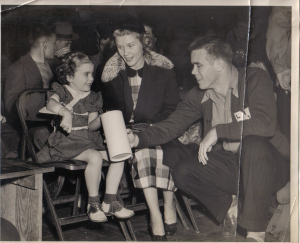 Today, October 28, is the 100th birthday of Dr. Jonas Salk, whose 1955 polio vaccine eventually eradicated this crippling disease in the United States. Google is saying thank you to Dr. Salk today through their search engine doodle. Between 13,000 and 20,000 polio cases occurred annually before the vaccine. Within 10 years of Salk’s vaccine, that number dropped to 61 cases a year.
Today, October 28, is the 100th birthday of Dr. Jonas Salk, whose 1955 polio vaccine eventually eradicated this crippling disease in the United States. Google is saying thank you to Dr. Salk today through their search engine doodle. Between 13,000 and 20,000 polio cases occurred annually before the vaccine. Within 10 years of Salk’s vaccine, that number dropped to 61 cases a year.
My mother, Judy Travis Hampton, was a polio survivor. She is pictured here with my grandmother, Kathryn Travis. They attended a 1950s era Little Rock basketball game, where fans donated money for polio research.
As a preschooler, Judy woke up one morning and couldn’t move her arm. Alarmed, her mother Kathryn called their physician.
Fearing the contagious nature of polio, the doctor told Kathryn to bring Judy through the back door of his office to avoid other patients. He then confirmed that Judy had polio.
Enduring bed confinement and quarantine, she eventually resumed normal activities while also attending physical therapy sessions at the local pool. Though she couldn’t lift her right arm above elbow-level, she went on to live a normal, productive life and became a teacher, wife, mother, and avid quilter. She was lucky. Some polio survivors, such as President Franklin Roosevelt, were unable to walk.
In May 2014, Judy died of Parkinson’s, a debilitating disease that affects the central nervous system, the same system that polio targeted. Her Parkinson’s case was likely worse and more aggressive because of the damage left by polio.
Earlier this month, Ann Romney, the wife of former Massachusetts Governor and presidential candidate Mitt Romney, announced the Ann Romney Center for Neurological Diseases at Brigham and Women’s Hospital in Boston. This work is important. America needs another “Jonas Salk” to find more effective treatments and cures for diseases such as Parkinson’s, Alzheimer’s, and Multiple Sclerosis, and brain cancer.
Jane Hampton Cook is the award-winning author of eight books, including her newest America’s Star-Spangled Story and American Phoenix. http://www.janecook.com/books.htm


Midterms and the Sixth Year Itch: 1938, FDR
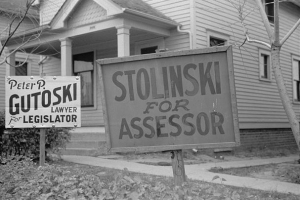
1938 Election Signs, Library of Congress
Midterm elections often fall into a pattern where the president’s party loses seats in the U.S. House and Senate. Sometimes the American people have a six-year itch, showing their objections to the president’s policies by voting against his party in the midterms.
The presidency of Franklin Roosevelt in 1938 had reached its sixth year since his first election 1932. The Great Depression had so ravaged and decimated the Republican Party, that the Republicans had remained very weak in the midterm elections of Roosevelt’s first term. They’d lost nine seats in the House and nine in the Senate in 1934.
Midterms in his second term were a different story. Republicans picked up 71 seats in the U.S. House in 1938 and seven in the Senate, reinforcing the American people’s sixth year itch. A recent recession within the Great Depression and Roosevelt’s plans to alter the U.S. Supreme Court by forcing retirements and increasing the number of justices had played a role in his party’s congressional defeat. As large as these numbers were, the gains weren’t enough for the Republicans to regain control of either house.
Then the president threw a political curve ball. Doing what his cousin Theodore had dreamed but failed to do, Roosevelt broke the long-held tradition of confining his presidency to two terms. He ran and won the presidency two more times, in 1940 and 1944, making him the only U.S. president to be elected to four terms. The American people may have had a sixth year itch in 1938, but it wasn’t long lasting.
Jane Hampton Cook is the author of America’s Star-Spangled Story and American Phoenix and six other books. http://www.janecook.com/books.htm





